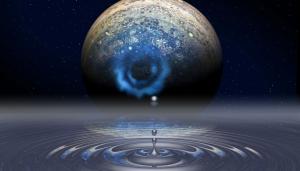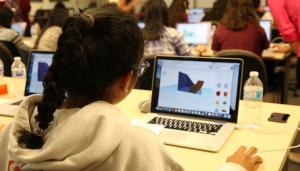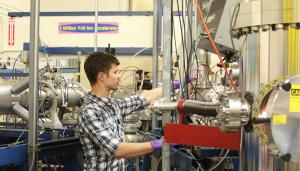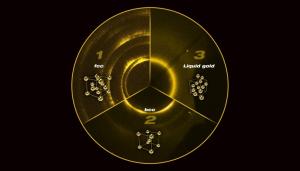LAB REPORT
Science and Technology Making Headlines
Feb. 3, 2017


Hydrogen undergoes an elusive metallic form under high pressure. Image courtesy of Royal Society of Chemistry
Hydrogen's holy grail
Hydrogen is full of secrets, and a research team is cracking one more.
Scientists have been chasing hydrogen’s elusive metallic form for more than 80 years, foiled by the high pressures required to create it. Harvard researchers have caught the telltale glint of metal in their apparatus. Experts consider this novel state of hydrogen a “holy grail” of solid state physics for its potentially world-changing applications, from rocket fuel to ideal electric wires.
It starts with the universe's most common atom. “We all love hydrogen,” said physicist Gilbert Collins of Lawrence Livermore National Laboratory, who was not involved in the research. “It has the essence of being simple, so that we think we can calculate something and understand it, while at the same time it has such a devious nature that it’s perhaps the least understandable material there is.”


LLNL software engineer Russ Fleming, left, and computer scientist Danielle Sikich, right (standing), helped facilitate the Girls Who Code club at Granada High School in Livermore last fall. Photo by Randy Wong
Girls crack code
Lawrence Livermore and the Livermore Valley Joint Unified School District (LVJUSD) are partnering to introduce coding and basic computer programming skills to middle- and high-school students during after-school Girls Who Code clubs.
Girls Who Code, a nonprofit organization, strives to support and increase the number of women in computer science. The Livermore Girls Who Code clubs are collaborations involving the national nonprofit program, the school district and the Laboratory. The program provides training and curriculum to LLNL volunteers who partner with teacher volunteers. Together, they engaged more than 150 students two hours each week for a 10-week course. The clubs are held at all seven comprehensive middle and high schools in Livermore. They are open to girls and boys.
District Coordinator for Girls Who Code, Regina Brinker, said: “We are thrilled with the high number of participants, which shows the depth of interest our students have in learning computer programming.”


Researchers are sunlight and the atoms in water to generate hydrogen energy.
Just add sunlight and water
A Lawrence Livermore scientist and collaborators are working on generating hydrogen, a carbon-free energy source, from sunlight and water.
The technology uses photoelectrochemical cells (PECs), which absorb sunlight and drive water-splitting reactions to produce hydrogen.
LLNL’s Lawrence Fellow Anh Pham and colleagues reviewed the methods used to understand the interfaces between photoabsorbers, electrolytes and catalysts in PECs. To be successful and scalable, PECs must be efficient, low cost and long lasting. Building an efficient PEC requires a high volume of semiconducting photoelectrode materials.


Lawrence Livermore scientist Joseph Wallace adjusts the microbeam aperture on the Rutherford backscattering spectrometry system, which is used to characterize radiation damage as a function of depth in the samples.
Detecting radiation’s pulse
Materials scientists at Lawrence Livermore have used a novel pulsed-ion-beam method to identify mechanisms of radiation defect formation in silicon.
The research could have implications for improvements in modern electronics performance.
The exact pathways of defect formation, however, have remained elusive, and most current predictions of radiation damage are essentially empirical fits to experimental data. This applies even to the best studied and arguably simplest material, crystalline silicon, which is the backbone of modern electronics. Until recently, scientists lacked experimental methods that could directly probe the dynamics of defect creation and annealing.
The team from LLNL and Texas A&M University used a new experimental method to study thermally activated defect interaction processes in silicon. The method exploits pulsed, rather than continuous, ion beams capable of probing defect interaction dynamics.

This image, taken by an astronaut in early 2003, shows the land-sea interactions along a section of Mexico’s west coast just south of Mazatlan and the Isla Marias archipelago. The islands are a manifestation of intersecting plate boundaries.
Plate tectonics go to the core
The heat from Earth's core has a significant effect on tectonic plate movement.
The new research challenges the previous school of thought that movement of Earth's tectonic plates is driven largely by negative buoyancy created as they cool.
The team, including Lawrence Livermore scientist Nathan Simmons and university collaborators, combined observations of the East Pacific Rise (the Earth's dominant mid-ocean ridge) with insights from modeling of the mantle flow beneath the Pacific Ocean.
"It's likely that heat from the deep Earth plays a significant role in global plate tectonics," Simmons said. "The cooling and sinking of plates is not the only significant plate-driving force."


Restructuring gold at the nano level can create a better catalyst.
Worth its weight in gold
New research shows that the phases that nano-structured materials go through to become an efficient catalyst are as good as gold.
Lawrence Livermore material scientist Juergen Biener and collaborators found that by restructuring nanoporous gold alloys they become more efficient catalysts. (A catalyst is a substance that enables a chemical reaction to proceed at a usually faster rate or under different conditions than otherwise possible.)
Nanoporous gold, a porous metal, can be used in electrochemical sensors, catalytic platforms, fundamental structure property studies at the nanoscale and tunable drug release. It also features high effective surface area, tunable pore size, well-defined conjugate chemistry, high electrical conductivity and compatibility with traditional fabrication techniques.





